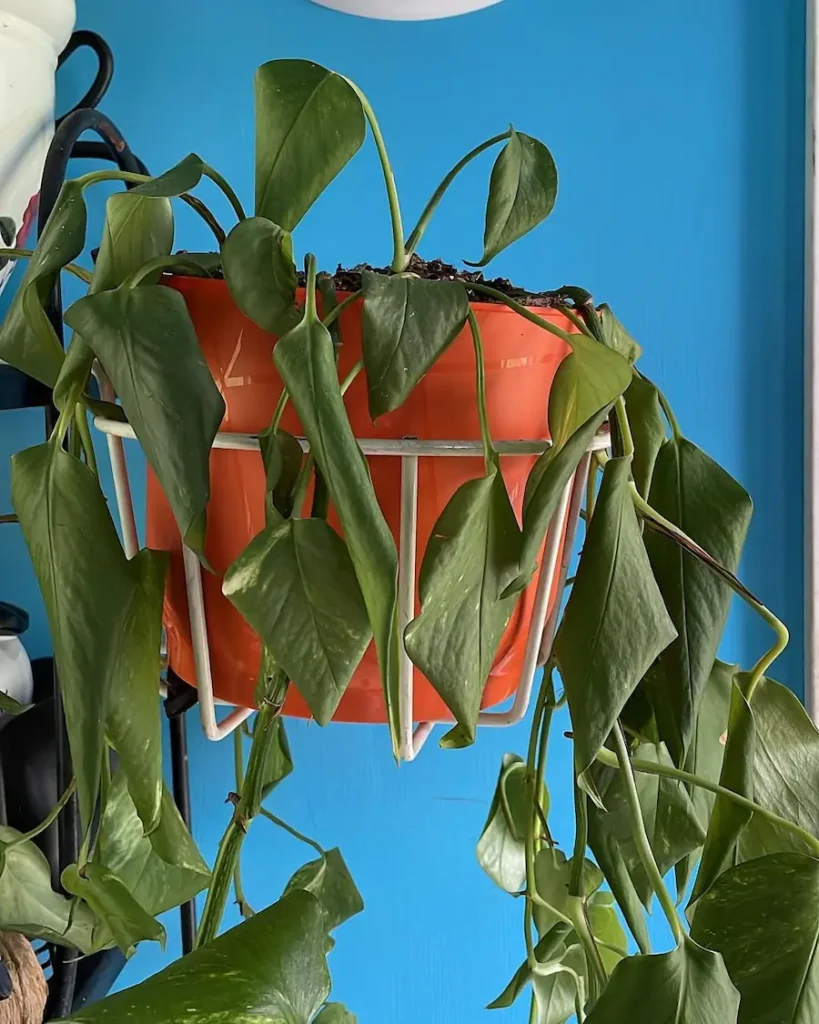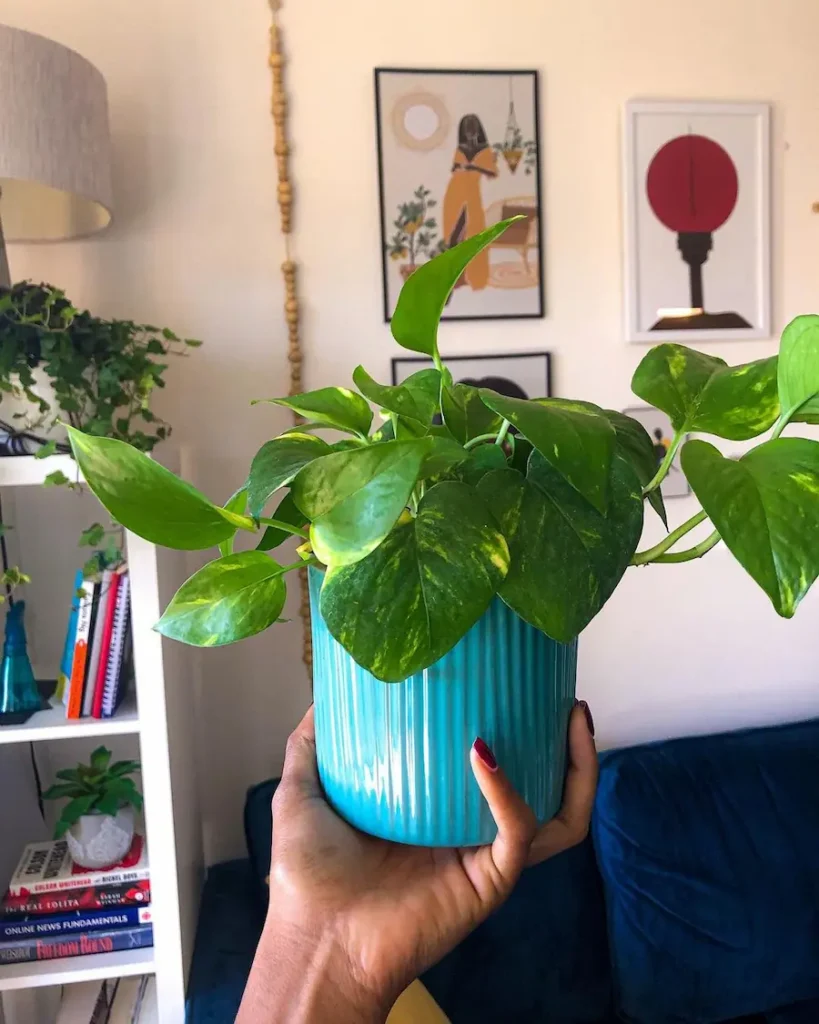Drooping Pothos: Reasons and How to Revive It
A healthy pothos plant should have green, glossy, and firm leaves. They should not appear wilted, yellow, or have brown spots or edges. Stems should also be firm and sturdy, not limp or brittle.
So, if your pothos is drooping, then something isn’t right.
Hello, I’m Alex Worley, a certified master gardener and plant care expert. In this article, I’ll help you troubleshoot a wilting, drooping pothos and restore its health.

Pothos is one of the easiest houseplants to nurture, making it a perfect choice for first-time plant lovers. It all depends on the conditions you give it. Pothos leaves may droop due to many factors, which can be corrected as soon as possible.
Why is my pothos drooping?
The following factors will cause your pothos to droop:
1. Dry soil
Start by checking if the top 2-3 inches of the potted soil is dry using your finger. If it is, then your pothos leaves could be drooping and turning color due to lack of water in the soil. A healthy pothos plant thrives in soil that’s damp. You should neither underwater nor overwater it. Keep a balance between the two watering methods.
2. Overwatering
Overwatering is another cause of droopy and wilting pothos leaves. If you stick your finger in the soil and notice that it is soggy, then it means you’ve been overwatering it. The best thing to do in that case is to reduce the watering frequency.
Also, if the soil doesn’t drain off water properly, it is time to swap it with organic-fed soil.
3. Fungal infection
A pothos plant may get a fungal infection known as root rot if growing on soggy soil. The plant may develop this disease if it is frequently overwatered. When left untreated, root rot can cause your pothos leaves to turn yellow, wilt, droop. Its stems will also turn brown. Treatment in its early stages can help revive the plant.
4. Lack of humidity
If your place is cool and dry, your plant’s leaves may droop and become crispy. Unless you adjust the temperatures, which increases humidity around your plant, the symptoms might not improve.
Either you add mist to the leaves using a spray bottle or place the pot near a humidifier. Please don’t place it near an air conditioner as the air around this appliance is dry.
5. Freezing temperatures
It is common for pothos to go limp during winter when most places are experiencing freezing temperatures.
However, that’s not an excuse to neglect the plant. Once you predict the upcoming frost, you can water your plant the day before. You can also raise the room’s temperatures using a heater or place the pot near a fireplace.
6. Transplanting shock
Plants like pothos are likely to suffer from transplant shock even if you don’t interfere with their roots.
As the plant acclimatizes to its new environment, the leaves may wither or droop.
It is more like you relocating to a new place with a different climate setting. You may develop medical conditions since your body hasn’t adjusted to your current environment. With time, your body develops coping mechanisms.
Can you revive wilting pothos leaves?
Wilting is one of the phases a pothos plant may go through if you neglect it. You can revive the plant if you identify the cause early enough.
For example, if its leaves are droopy due to overwatering, you can reduce the watering frequency to once per week instead of daily. Also, many factors such as where the plant is placed in the house, how much light it receives, and the pot’s size can affect your watering.
How do you fix drooping pothos?
Fixing a droopy pothos plant starts with getting the following care steps right.
1. Water pothos when the soil dries
The right way to determine if your plant receives enough water is by testing the moisture levels in the soil using your fingers. If the top two inches are dry, it is time to water your pothos.
However, if it’s still damp in those two inches, then you can postpone watering. Check again after a few days.
The best watering method for a pothos plant is placing its decorative pot in a pan of water instead of sprinkling water from the top. Let the pot sip the water through its drainage holes.
You will know the pot has drunk enough water when the drainage holes have stopped leaking excess water.
2. Change the soil to a well-draining soil
Overwatered pothos in poorly drained soil can droop due to a lack of oxygen. Instead of water traveling to the roots, it will settle on the walls of the container.

The first remedy to overwatering is unpotting the plant so that you can examine its root system. If its roots are flaccid and appear mushy, it means you’ve been overwatering it.
The second step involves doing away with the old potting mix and replacing it with well-drained soil. The best soil for pothos should contain enough organic matter and perlite. The more it drains off fast, the easier it will increase airflow so that the roots receive sufficient oxygen.
Also, the pot or container your pothos is growing on should be relatively shallow and have ideal-sized drainage holes. This prevents excess water from pooling at the bottom of the container, encouraging fast drainage.
3. Fix humidity to 50% and temperature to 65°F
Pothos require steady temperatures of 65°F and humidity levels between 40-50% all year-round. Sudden change in the atmosphere makes them more prone to droopiness. They don’t do well in places with cool and dry air, either. Therefore, it’s safer to grow them indoors if outdoor temperatures keep fluctuating.
It would help if you considered placing them in rooms that get extra water particles in the air, like your bathroom or kitchen. Alternatively, you can increase the humidity levels it lives in by investing in a humidifier.
Don’t place them near heaters or air conditioners because these appliances rob off moisture from the air. Finally, placing them next to houseplants with enough humidity is another way of encouraging a micro-climate atmosphere in your house.
4. Transplant your pothos during early spring or fall
Fortunately, the signs of droopy leaves due to transplant shock can reduce as long as you re-pot your pothos correctly. It is still adapting to its new environment. In a few days, you should see it spring back to life once it gets used to it.
But first, you should ensure you re-pot is a moist pot. Place the pot under a shade for a few days, away from direct sunlight.
5. Treat root rot using fungicide
After unpotting your plant and confirming that it has root rot, it’s time to dip it in a fungicide solution. Besides treating the disease, the solution also prevents the roots from getting attacked by opportunistic pathogens.
Again, soil sogginess is what encourages the growth and multiplication of fungi. You can avoid this in the future by only irrigating your pothos when the soil is two to three inches dry beneath the surface.
Once you identify the reason your pothos plant is drooping, ensure you fix it immediately. The plant may be tolerant but can quickly wilt and die if you don’t fix the cause of its droopiness in good time. With time, it will bounce back.



![Pothos Leaves Curling [Causes + Easy Ways to Fix Leaf Curl]](https://gardenine.com/wp-content/uploads/2020/11/Pothos-leaves-curling.jpg)

![Pothos vs. Philodendron: Differences [Pictures + Identification]](https://gardenine.com/wp-content/uploads/2020/12/Pothos-vs-Philodendron-leaf-shape-and-texture-768x576.jpg)

